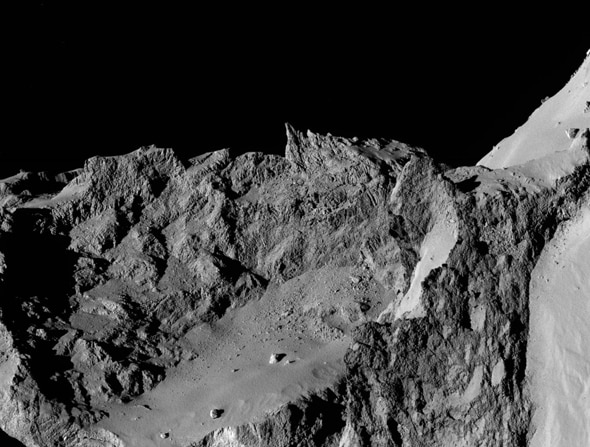Create a free profile to get unlimited access to exclusive videos, sweepstakes, and more!
Comets Scoff at Gravity

On Earth, we are keenly aware of gravity. It shapes and modifies everything we do, including our architecture, our behavior, and the landscape around us.
Comets, on the other hand, think of gravity as more of an afterthought.
The image above is from the Rosetta spacecraft, still traveling along with the comet 67P/Churyumov-Gerasimenko as it orbits the Sun. Both were about 474 million kilometers from the Sun and 449 million kilometers from Earth when this shot was taken.
Rosetta was considerably closer to the comet than that, of course. It was just a hair under 30 kilometers from 67P when it snapped this shot, and the resolution on the full-size image is a stunning 0.5 meters per pixel: about 18 inches!
I love the jagged peaks surrounding the flatter plain, towering shards 100 meters high that clearly don’t have to deal with a whole lot of forces like gravity, wind, and the like (another angle on this same region can be seen here). You can see rocks resting comfortably at all sorts of weird angles, partially due to friction with the surface being more than enough to overcome any sliding due to the weak gravity, but also because “down” becomes a complicated topic if you’re standing there. The comet has two big lobes connected by a thin neck, and what you call “down” changes rapidly and strongly with position.
In general, if you were standing on the surface, you’d feel gravity something around 0.0001 times that of Earth. I’d weigh about a quarter ounce, as much a sip of water. A solid jump would fling you away from the comet forever.
The reason behind this is simple: Comets aren’t terribly big—67P is roughly four kilometers across and has a mass considerably less than a typical Rocky Mountain. This makes the force of gravity on the comet pretty weak, barely enough to hold it together.
Even though conditions on the comet seemingly defy the forces we deal with on the surface of our much larger planet, the comet is actually incredibly fragile. It’s made of rock and ice, and when it gets near the Sun on its 6.4 year orbit that ice turns into a gas. This can dislodge rocks, shift surface features, and generally erode things away (and also create the iconic tail of a comet). In a relatively short time (millions of years? Less?) the comet will lose its structural integrity and fall apart. We’ve seen comets do this.
Such will be the fate of 67P as well. But in the meantime, there’s much to learn! Rosetta is still observing the comet, still sending back valuable data, and still helping us understand these bizarre frozen remnants of the solar system’s past.
My thanks to Emily Lakdawalla who helped me find the location of this shot on the comet’s surface. Follow her on Twitter!


























